As Thule’s most affordable rack, the Thule Passage bike rack provides dependable usability and features without skimping on quality and performance. Available in 2 or 3 bike capacity, the Passage allows you to safely and easily transport your bikes across town or to the trailhead – without the need for a hitch.
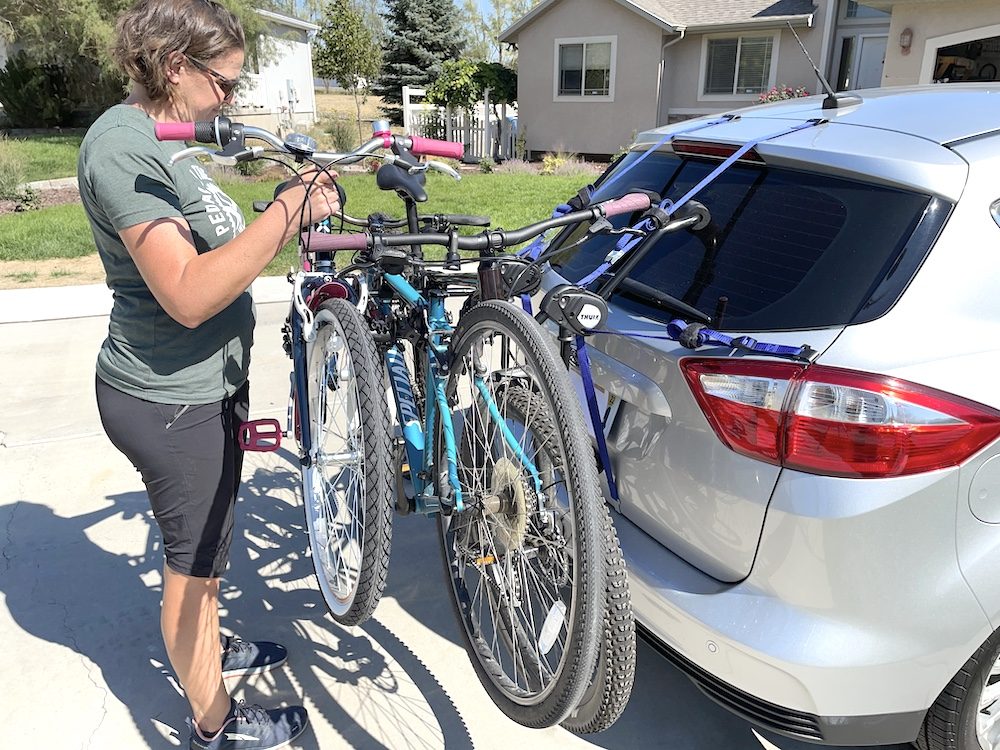
Like all bike racks, which are finicky by nature, the Passage certainly isn’t for everyone (even if it does fit on your car). But if it is a good fit for your car and your bikes, it provides exceptional quality for its price.
Thule Passage Bike Rack Overview

RATING: Highly Recommended
MSRP:$159 – $179
BEST FOR: Hauling hybrid, road bikes, and heavier or larger-framed bikes (with some exceptions).
CAPACITY: 2 or 3
SUPPORT BARS WIDTH: 15″
CRADLE SPACING: 4.5″
PROS:
- Extra wide base provides plenty of stability, especially for larger bikes
- Anti-sway cradles minimize bikes’ ability to swing into each other en route
- Support arms fold down when not in use
- Extra tall cradles offer more support to bike’s frame
- Easy to use rubber cradle straps
- Highly adjustable to fit most sedans
CONS:
- Cradles are very close together (4.5″), which greatly increases the likelyhood of bikes making contact while on the rack – especially bikes with suspension forks
- Wide support bars don’t accomodate many small kids bikes
- Tall cradles prevent support arms from being able to thread through bikes with narrower frame triangles
- Not compatible with most hatchbacks (we got lucky with the Ford C-Max shown in this review)
Thule Passage Trunk Mounted Bike Rack – Results of our Testing
From kids bikes to mountain bikes, we put the Thule Passage bike rack to the test with a wide variety of bike sizes and styles. Considering we have a lot of bikes at our disposal, but not a lot of cars, we only had the chance to test the Passage on two cars, a 2003 BMW 3-series and a 2017 Ford C-Max.
After hours of testing, we are confident that the tips and tricks we learned will help you determine if the Passage is the best bike rack for your fleet of bikes.
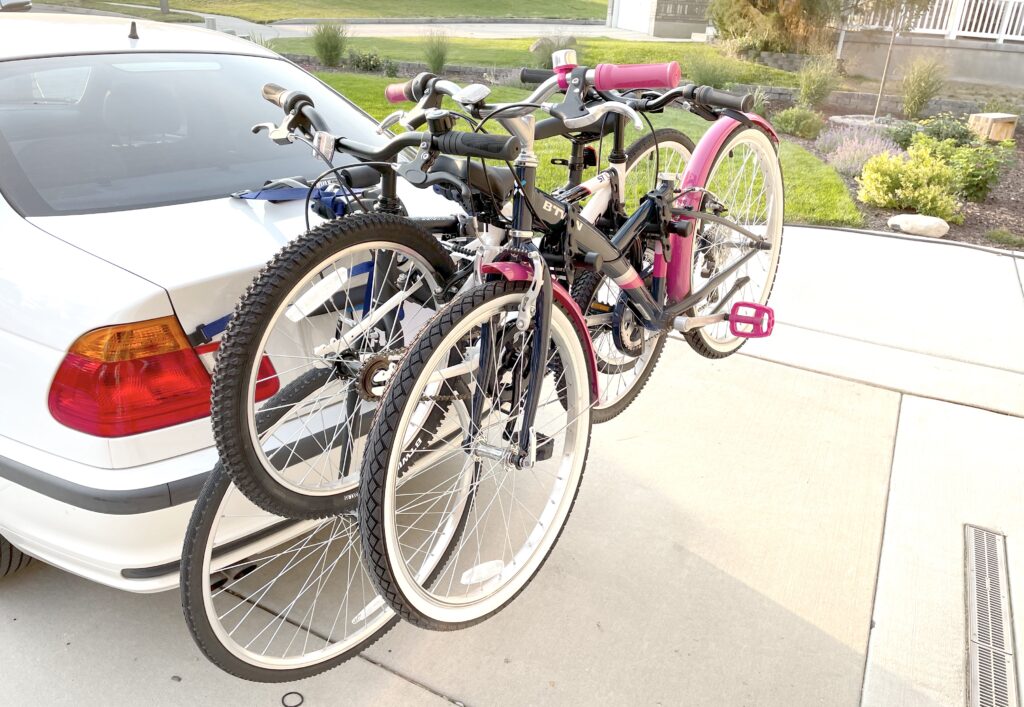
How does the Thule Passage Work?
The Thule Passage mounts to the trunk or rear hatch of your car via six straps. Two on the top, two on the sides, and two on the bottom. These straps stabilize and firmly hold the body of the rack onto your car.
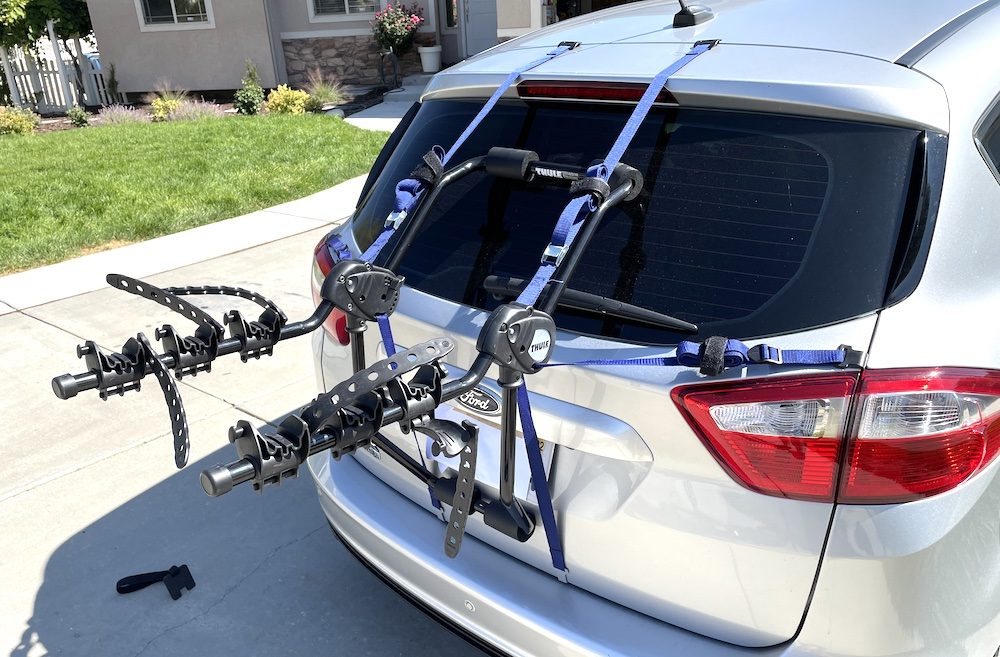
The hooks on each strap are coated to prevent your car from being scratched, but we would recommend using car protectors just in case. Foam feet wrapped around the base of the rack prevent the trunk, bumper, or rear hatch of your car from being damaged as well.

The bikes are placed into protective cradles along the support arms of the rack and then secured with a rubber strap.

Unlike Thule’s higher-end Gateway Pro trunk rack, the Passage trunk rack does not lock to your car and could easily be removed by an eager thief. The rack also does not provide a way to lock the bikes onto the rack, so while the rack will keep your bikes secure during a drive, it does not provide any anti-theft measurement.
Will the Thule Passage Fit on my Car?
With all trunk racks, it’s vital to check the manufacturer’s website to determine if the rack will fit on your car. If it doesn’t fit on your car, digging deep into the details of this review certainly won’t do you any good.
Thule’s Fit My Car guide will help you determine if your car can accommodate the Passage. Once there, be sure to click on “rear” on the mounting location for the filter to show trunk racks and not hitch or roof racks.
Based on our experience with the Passage, we found it to be compatible with most sedans, but not compatible with most hatchbacks or any car with a spoiler.
Will my bike fit on the Passage?
Some bikes are a perfect fit for the Thule Passage, while others are problematic or impossible to fit. We tested the rack with many bikes in our fleet to help you determine if your bike will fit. Here’s a quick summary.
Thule Passage Bike Fit Summary
FITS:
- Most road bikes and hybid bikes
- 20″ and 24″ kids bikes (adapter bar may be needed)
- Mountain bikes with a long straight top tube (but only be able to mount 2 on a 3-capacity rack or 1 on a 2-capacity rack)
DOES NOT FIT:
- Most full suspension mountain bikes
- Mountain bikes with smaller upper triangles
- Multiple bikes with wide suspension forks (must leave a cradle empty between wide bikes)
- 16″ kids bikes
- Bikes over 35 lb.
Hybrid Bikes and Road Bikes
The Thule Passage fits road and hybrid bikes much better than it fits with most mountain bikes, especially mountain bikes with more modern geometry. Also note that carbon frame bikes should never be hung from the frame, so do not use the Passage (or any trunk rack) on a bike with a carbon frame.
Bikes with a long straight top tube that have at least 16″ of space beneath it for the rack’s support arms to thread through, typically fit on the Passage. With hybrid and road bikes, we didn’t have any issues as their frames provided plenty of space.

Kids Bikes
Due to the Passage’s wider set bars, we were not able to get a 16″ bike (or smaller) to fit onto the Thule Passage.
We tested out several different 20″ and 24″ kids bikes and were able to get all but one of them to fit on the Passage without the need of an adapter bar (more about these below). In the image below, the red arrow is pointing to a 20″ kids bike and the blue arrow is pointing to a 24″ kids bike.
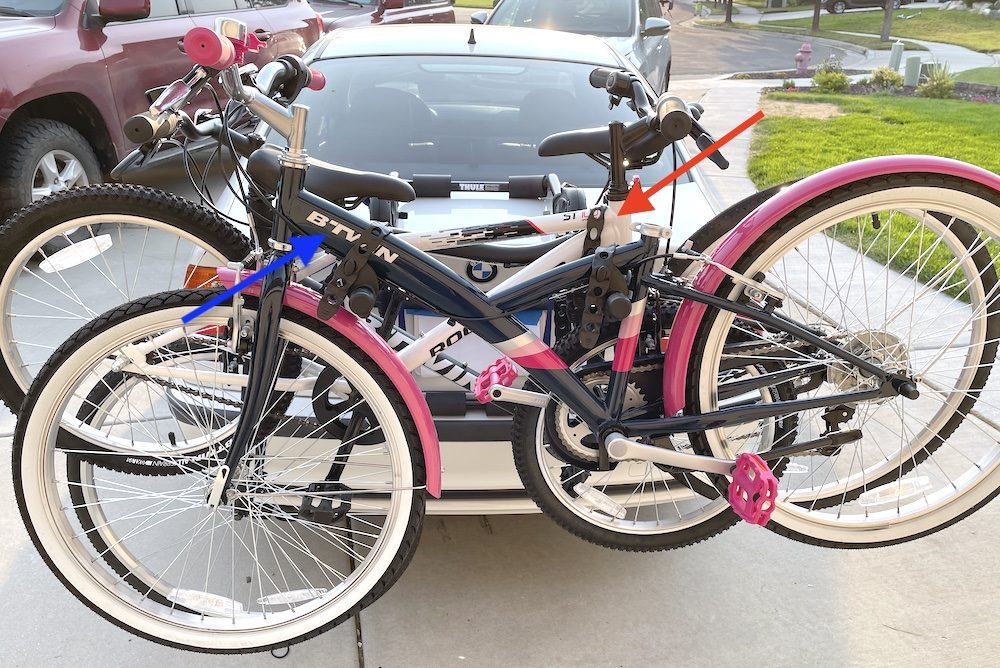
The one exception we found was the woom 4 as the cradle of the Passage was too big to thread through the bike’s frame, but the bike was able to mount with an adapter bar.

Mountain Bikes
On modern mountain bikes, we found the tighter angles along the head tube, top tube, and bottom tube to be problematic with the Passage. With minimal space between the top tube and the bottom tube, there wasn’t enough room for the 3.5″ tall cradle of the Passage to fit under the top tube of the bike seen below.

We were, however, able to get the bike to mount by placing one cradle under the downtube of the bike. This trick works due to extra space between the front tire and the downtube due to the suspension fork.
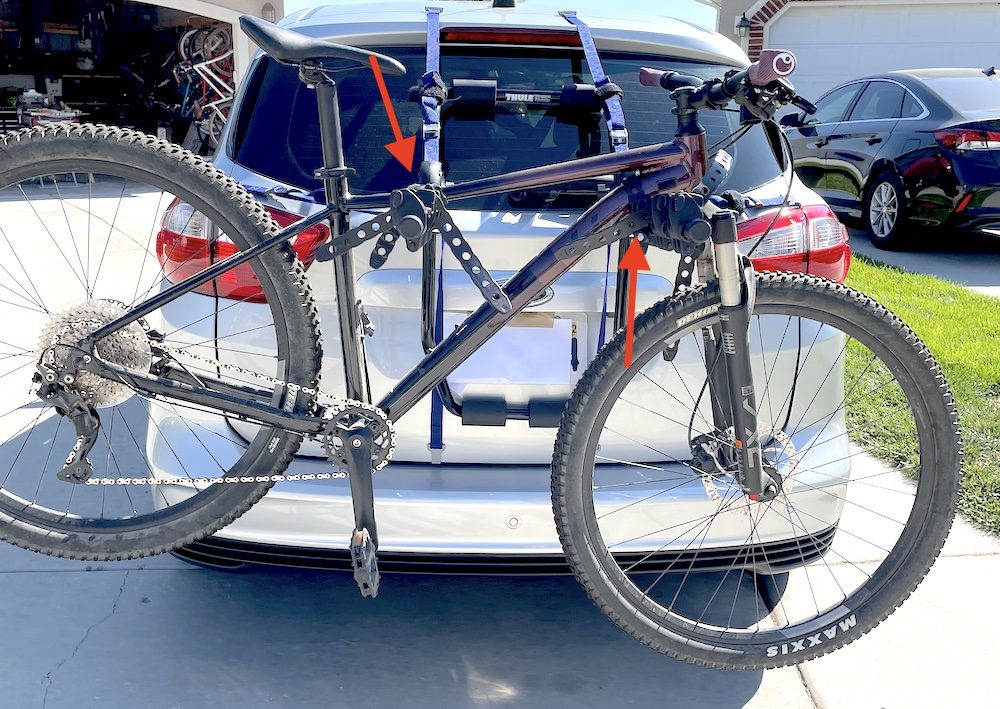
As long as you have 16″ of space between the upper corner between the seat tube and the top tube and the downtube, your bike should fit this way.

Vertical Clearance with Larger Bikes
In fact, after testing several different bikes on the Thule Passage, we actually prefer to mount large wheeled bikes (both hybrid and mountain bikes with 700c, 27.5″ or 29″ tires) this way. Why? By mounting one cradle onto the downtube of the bike, it raises the front tire and provides much more clearance from the ground.
Ideally, the bottom of a bike’s front tire should be a minimum of 12″ off the ground when the bike is loaded on the trunk rack. This is VERY hard to accomplish when mounting large bikes with large wheels on smaller cars.
With the bike shown below (a large framed 700c hybrid), when mounted with both cradles under the top tube, the front tire only has 7.5″ of ground clearance.
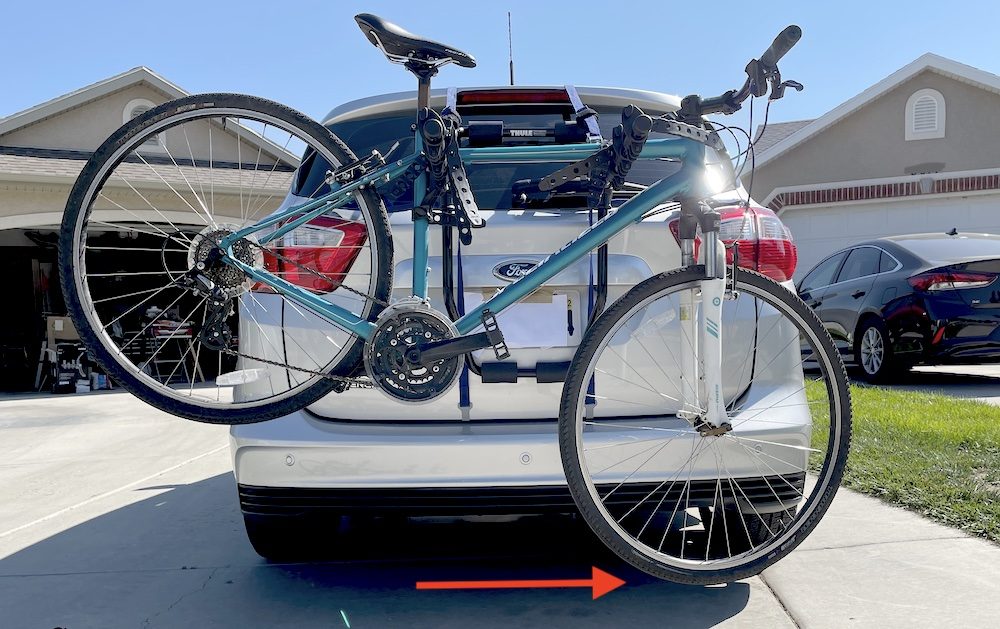
When mounted via the top tube and the downtube, the front tire was raised 7″, to provide a much safer 14.5″ of clearance.
On our 29″ large-framed mountain bike, the bike was not able to mount via the top tubes, but when mounted by the top-tube and the downtube, the front tire had 12″ of clearance.

Additional Fit Issues with Mountain Bikes
The downside of this method is that it places the bikes higher on the rack, which leads to other issues when attempting to load additional bikes on the rack. With the frame sitting higher on the frame, it can get in the way of the handlebar of the neighboring bike on the rack.

As a result, when loading larger adult bikes with this method, we recommend leaving an empty cradle in between the bikes. So if you want to haul 2 bikes, you should get the Thule Passage 3 capacity. If you want to haul 3 mountain bikes, the Thule Passage likely isn’t going to work for you.
In addition to proving space for handlebars, leaving an empty cradle in between the bikes also leaves room for the wider forks of mountain bikes. The fork on the Liv mountain bike shown below is 7″ wide, while the spacing between the cradles is only 4.5″. As a result, the fork of the Liv rubs up against the frame of the bike loaded next to it. If the bikes were separated by an empty cradle, the problem would be eliminated.

Also keep in mind that when loading multiple mountain bikes onto a trunk rack, you often have to remove the saddles to make the bikes fit (because handlebars often interfere with saddles). Due to the wide handlebars of mountain bikes, this is an issue even if you skip cradles. If the bikes have dropper posts, however, removing the saddle isn’t an option.
If you are only hauling one bike on the Passage, you won’t need to remove your saddle. As long as the bike fits, you should be good to go!
What About Top Tube Adapter Bars?
If a bike does not have room beneath the top tube, top tube adapters are available to simulate a long, straight top tube. However, these adapters should be used with caution, especially on lower cars!
Although easy to use (they simply “clip” on between the stem and seat post of the bike to make the simulated top tube), they often lead to ground clearance issues, especially when used with larger bikes with larger wheels (27.5″+).
When mounted to our smaller Ford C-Max, larger bikes mounted to the Passage with an adapter bar sat very low to the ground. 12″ of clearance is recommended, but the bike shown below only had 4″ of clearance!

We actually mistakenly dragged the front wheel of the white bike when pulling out of the driveway with only a slight incline! So unless you don’t have to battle any speed bumps or inclines or declines during your trip, we highly recommend avoiding using adapter bars on larger bikes.
When mounted without an adaptor bar, however, the front wheel had 13.5″ of clearance!
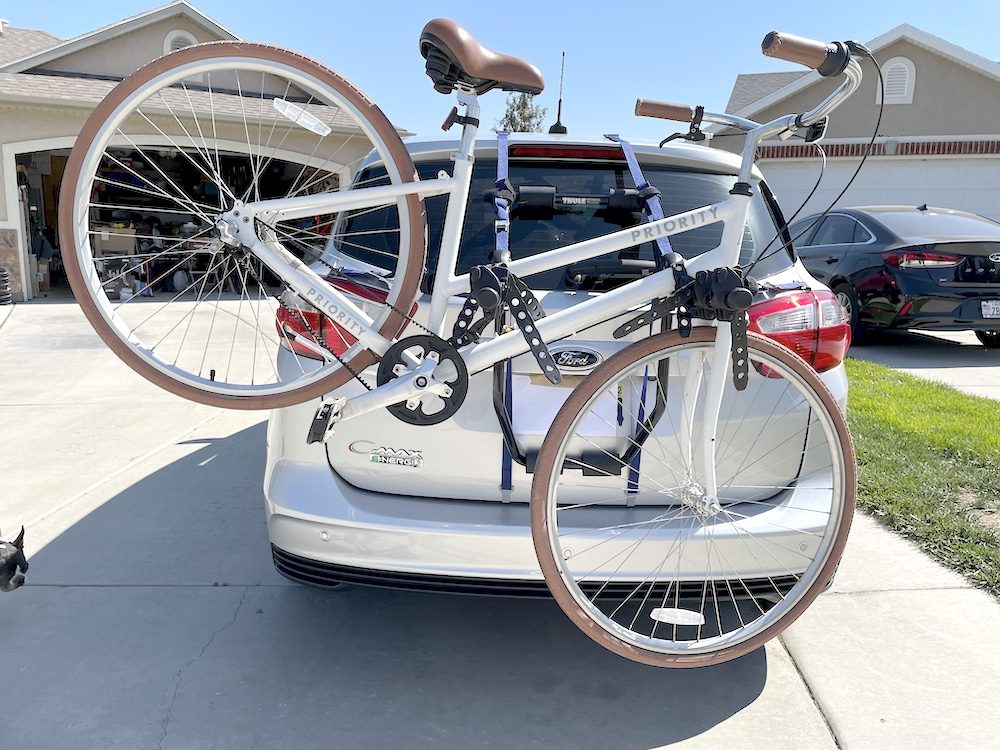
Standout Features of the Thule Passage
If the Thule Passage is compatible with your bike(s) as well as your car, it truly is a great rack for its price. Compared to other racks in its price point, we found four standout features of the Passage.
(1) Extra-wide Base: With the widest base of all the trunk-mounted bike racks we have tested, the Thule Passage does an exceptional job at distributing the weight of the bikes on the trunk of your car. This greatly reduces the likelihood of your car being dented as a result of using a trunk rack.
With 15″ support arms (measured center on center), the Thule Passage also provides a more stable base for individual bikes, especially larger framed and/or heavier bikes. With wider supports under the top tube of the bike, the bike itself is more stable on the rack and less likely to shift during transport – especially when compared to other racks with narrower support arms (support arms width can range from about 10″ to 15″).

(2) Tall, Supportive Cradles: For additional support, the cradles of the Passage are taller, deeper and wider than other cradles. With a deep pocket for the top tube to rest in, even bikes with taller, more oblong tubing, as well as bikes with wider tubing, were able to comfortably fit inside the cradles.
Each cradle also has several recessed grooves to allow brake cables to pass through without being pinched.

To keep the bikes snug and secure, the cradles are equipped with easy to use, rubber cradle straps.

(3) Anti-Sway Brackets: The anti-sway brackets of the Thule Passage come detached from the cradles and can easily and quickly be added to help prevent bikes from swaying into each other while en route. Less-expensive trunk racks like Allen Sports, don’t have anti-sway cradles.

NOTE: The anti-sway cradles only work if both main cradles are attached to the bike’s top tube. We were not able to get the cradles to work with bikes mounted at an angle, but the cradles easily come off so as to not be in the way.
(4) Fold-down Support Arms: When not in use, the support arms of the Thule Passage can quickly fold down. Whether you’re parking in a tight spot at the trailhead or want to be able to fit the car in the garage with the rack still mounted, fold-down arms are a simple feature that can offer huge benefits.

Tips for Loading Bikes on the Passage
Loading and unloading bikes onto a trunk bike rack can be either incredibly fast and easy, or ridiculously impossible and frustrating. After experiencing this ourselves, here are a few tips to help guide you onto the quick and easy track!
(1) Remove Bike Saddles: Due to the close proximity of the Thule’s cradle (4.5″ center-on-center as compared to the more expensive Saris Bones EX at 6.5″), there is a lot more interference between pedals and frames and handlebars and seats when loading the Passage.
While rotating a crank arm to get a pedal out of the way is pretty easy, navigating the world of fighting handlebars and saddles is much more challenging. In the end, we’ve found that if the battle persists, removing the saddles from the bikes is a quick and easy solution.
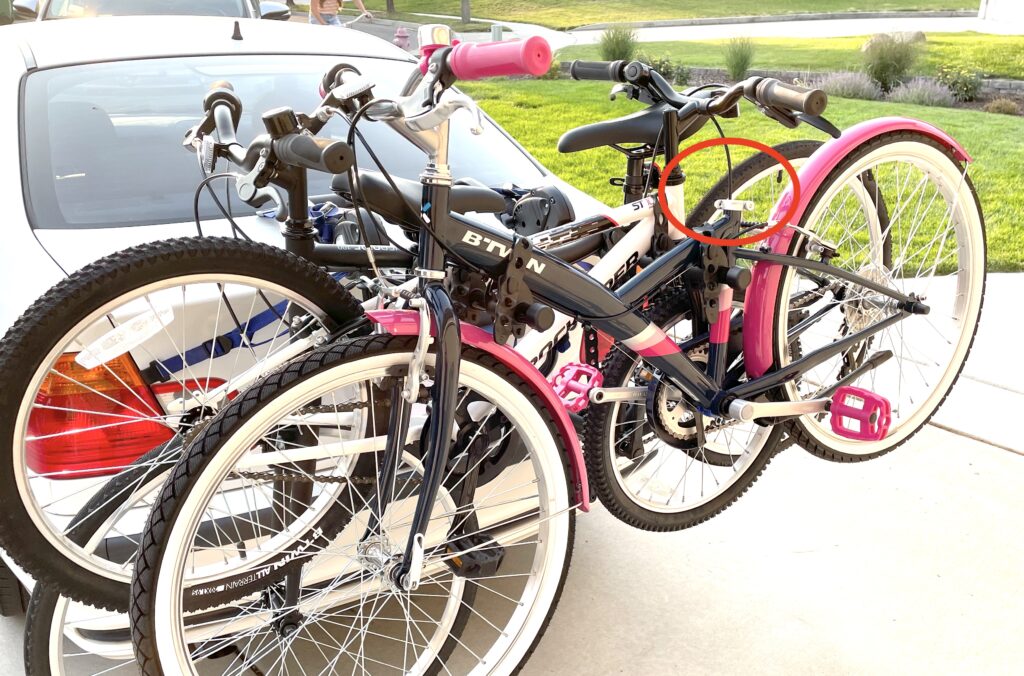
This, of course, isn’t an option for bikes with dropper posts, which is another reason why we believe the Passage is better for road bikes and hybrid bikes.
(2) Purchase and Use Velcro Straps: The extra webbing on all trunk racks can be a beast to deal with. We found securing the extra to the frame of the rack with Velcro straps to be a quick and simple solution. The Velcro straps also work great to secure the front tire of the bike closest to the car to prevent it from spinning and/or rotating and hitting the rear bumper during travel.
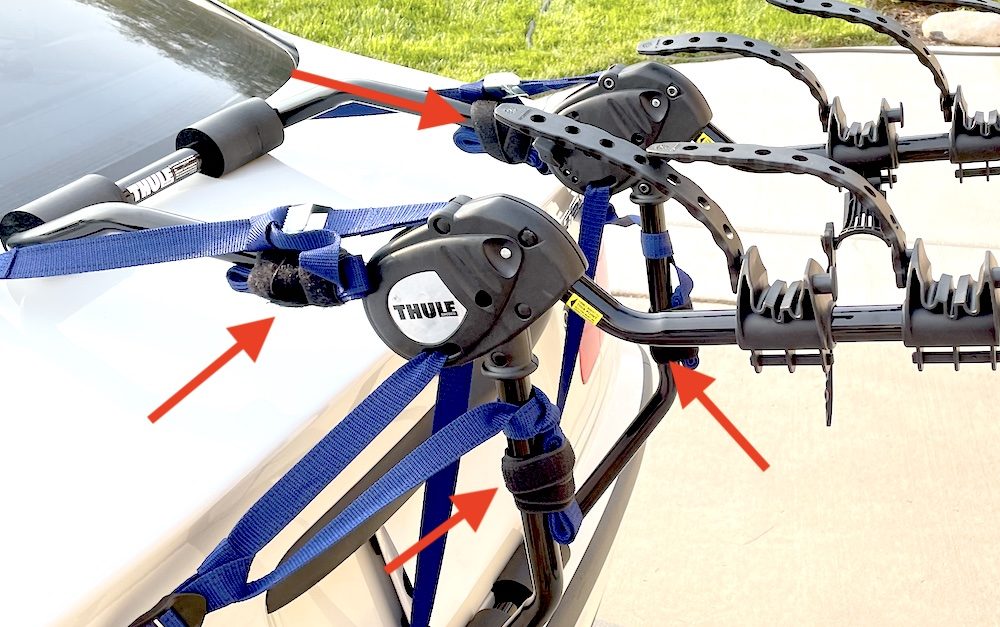
(3) Pay Attention to Car’s Exhaust: While not a common problem with sedans, damage to a bike’s wheels can happen when they are placed within close proximity to a car’s exhaust.
To prevent potential damage, be sure to load the first bike onto the rack with its rear wheel above the car’s exhaust (versus the front wheel). Since the front wheel typically hangs down lower than the rear wheel on a trunk rack, ensuring the front wheel is on the opposite side of the car as the exhaust can help prevent damage.

The subsequent bike will need to be loaded in an opposite direction as the first bike, but since the second and third bikes are loaded farther down the support arms and away from the car, the car’s exhaust isn’t an issue.
(4) Load Bikes Largest to Smallest: Loading the largest and heavier bike onto the rack first is essential for the stability of all trunk racks. Typically, loading largest to smallest is ideal, but with the 3-capacity rack, we found placing the smallest bike in the middle spot is helpful in order to get more spacing between the two larger bikes.
Tips for Using a Trunk-Mounted Bike Rack
For additional tips and tricks on how to use trunk-mounted bike racks, be sure to check out our Tips for Trunk Bike Racks Installation and Use on our Best Bike Trunk Rack article.
Thule Passage Bike Rack Bottom Line
Like any trunk rack, the Thule Passage doesn’t fit every car or accommodate every bike, but if you are luckily enough to have the Thule Passage work for you, you won’t be disappointed. Offering a wide base for plenty of weight support, as well as easy-to-use rubber straps and fold-down cradle arm, the Passage offers quality and performance with breaking the bank.
If you’re still not sure if you should be a platform or hanging rack, be sure to check out our 10 Best Car Racks for Families.
FTC Disclosure: Affiliate links are included in this review. No monetary compensation was provided for this review. All opinions and images are that of Two Wheeling Tots LLC. All content and images are copyrighted and should not be used or replicated in any way. View our Terms of Use.
